Throughout mobile app development, the next question clients usually ask after the cost of app development is, “How long will mobile app development take?”
The average development time of an app is highly dependent on factors such as the complexity of the app, how many features are required, the application size, the domain of the application, and the development team’s composition. Below is the average development time that is expected for each category of app.
- Simple App Development: 2-4 months
- Mid-Level App Development: 4-7 months
- Complex App Development: 7-12+ months
As a prominent mobile app development company, we have put our years of experience into this guide for the app development timeline breakdown. In this guide, we have covered the full app development process, every aspect that affects the time to build an app, and tips to reduce your app development time.
We recommend reading to the end to have a clear idea of how long your app will take to develop until market launch.
CTA SECTION START
cta title: Have an app idea in mind? Let’s estimate the timeline!
cta des:
cta button: Get your App Timeline Estimate
CTA SECTION END
Average App Development Timeline
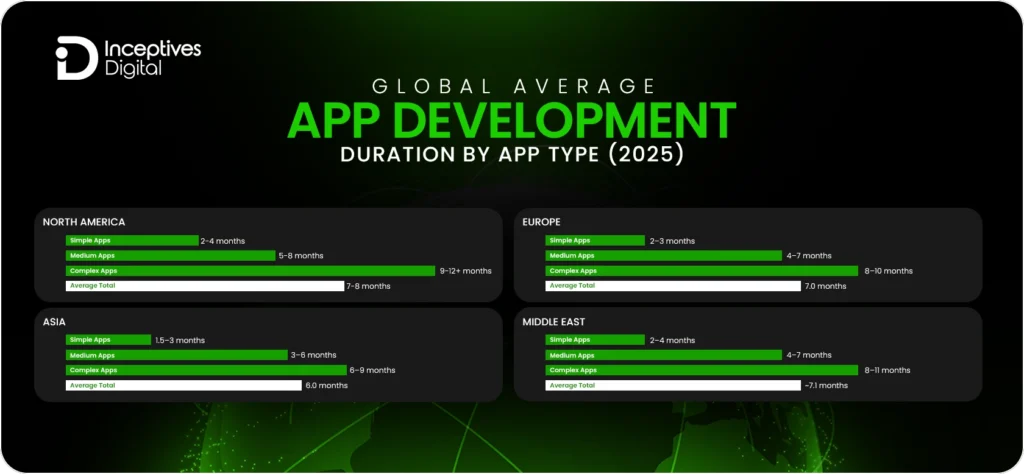
The app development timeline is determined by various factors. For example, an app that has more features and tech integrations will take more time to develop than a simple app with minimal features. If we talk specifically about the timeline of your app, the minimum time it can take is two months to more than a year.
Here we have constructed a comparison table for you to understand the app development timeline according to app complexity.
| App Complexity | Average Development Time | Example Apps |
| Simple App | 2–4 months | To-do list, calculator |
| Medium App | 4–7 months | Fitness tracker, food delivery |
| Complex App | 7–12+ months | E-commerce, fintech, social media |
CTA SECTION START
cta title: Curious about where your app fits in? Our experts can give you a realistic development timeline.
cta des:
cta button: Talk to an App Expert
CTA SECTION END
Native vs Cross-Platform App Development Time Comparison
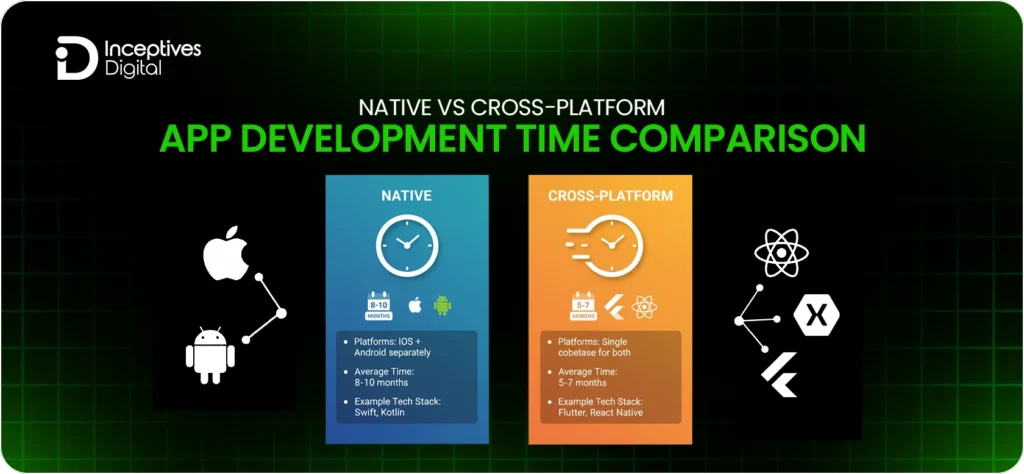
The development approach plays a vital role in determining the timeline of the app. It can either be native or cross-platform.
Native application development entails having individual applications developed for iOS and Android using the respective platform-specific languages and tools (Swift for iOS, Kotlin or Java for Android). Though this technique yields excellent performance and unparalleled user experience, it will be longer as the developers will have to not only write but also manage two separate code bases.
Cross-platform app development, however, will utilize one code base that will work on both platforms. Frameworks like Flutter, React Native, and Xamarin will decrease the time to build the app and also decrease redundant coding. Depending on app complexity, cross-platform app development can decrease the overall time to build an app by as much as 30-40 percent and will decrease costs.
Here’s a quick comparison:
| Development Type | Timeline (Approx.) | Description |
| Native App | 6–12+ months | Separate development for iOS and Android. Higher performance, but longer timeline. |
| Cross-Platform App | 4–8 months | Shared codebase for both platforms. Faster delivery with minor trade-offs in platform-specific features. |
If you want to develop an app that requires native like performance, like a gaming app. You should go for a native development approach. In case you want to launch quickly, but want to target the audience of both iOS and Android without overspending cross-platform development will be the best option for you.
Stage-by-Stage Timeline Breakdown of App Development Process
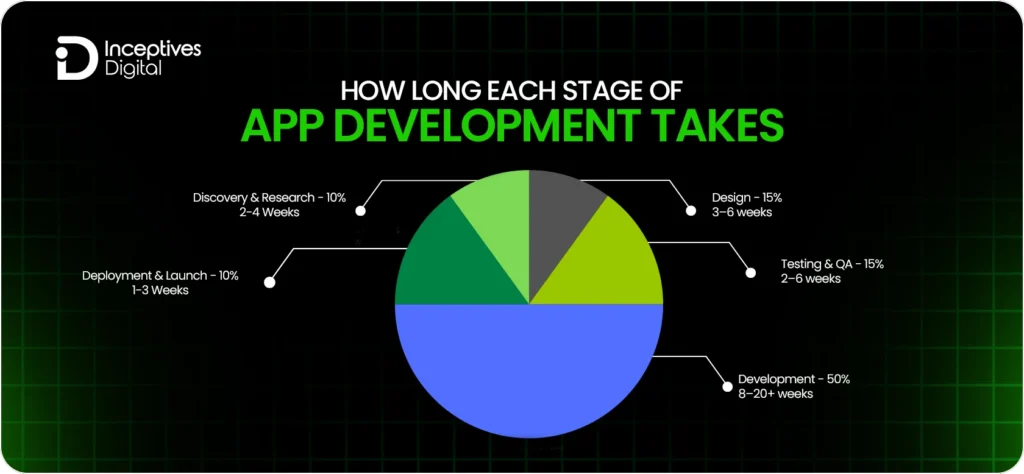
According to Clutch, if you consider all phases of a mobile app development project, from the initial planning to finally deploying the application, it will take at least 20 to 40 weeks to arrive at the final product. Below is a detailed timeline for each of the steps involved in the mobile app development process.
1. Discovery & Research Phase
This is the most critical phase that lasts for 2 to 4 weeks in the development of an application. In this phase, turn your mobile app idea into reality through validation, research of your potential users, competitive analysis, requirements gathering, and a clear roadmap that will lead to the development of your project. The importance of this stage is that you will be sure of your goals after that. It would be best if you collaborate with reputable mobile app developers for a clear and hassle-free roadmap for your project.
2. Design Phase
After making sure that your application’s fundamental plan is flawless, the very next step is the creation of the application prototype. The design stage places a lot of importance on UI/UX design to make sure that the application is user-friendly and attractive. It offers a developer’s blueprint enabling them to execute a well-organized approach throughout the overall development process.
Key Aspects of the Design Phase
a. Design High-Fidelity Wireframes
The design phase is initiated with low-fidelity wireframes that define the app’s core features, structure, and user experience. It usually takes 1 to 2 weeks, depending on the customizations.
After validating the features and logics, it is upgraded to high-fidelity wireframes. These wireframes assist in testing the app’s responsiveness, functionality, and aesthetics to make sure it aligns with your goals.
b. Build a Comprehensive UI Kit
The UI kit is a basic deliverable of the design phase, and its creation needs about a week to two weeks. It consists of reusable components such as buttons, sliders, navigation, widgets, and progress indicators. These pre-defined design elements help maintain visual parity across the application and consequently save developers a huge amount of time doing repetitive work.
The UI kit makes sure that the entire application is in tune with your brand identity and design guidelines by bringing together all these different elements in one place. Moreover, it helps keep the mobile application development timeline accurate, preventing unnecessary delays.
3. Development Phase
The development is considered the backbone and most time-consuming phase of the overall development process. This is where the developers add functionality to all the approved designs and features. The development phase consumes most of the time because it involves complex coding, third-party integrations, and careful testing. This phase generally is 8 to 20+ weeks long. Below is a breakdown of the different stages of the development phase:
- Backend Development
Writing code that will power your application is what backend development is. It handles databases, APIs, user authorization, and server logic. It usually takes 2 to 3 weeks, depending on the type of application and complexity level. For example, the time to build an iOS app and an Android app is more than a cross-platform app.
- Frontend Development
This is where the front-end developers bring the design approved at the start to life using modern frameworks. For a native app, the frontend is developed separately for both iOS and Android versions, which increases the development timeline. However, cross-platform app development can save both time and cost. The average frontend development timeline lies between 2 to 10 weeks.
- Third-party API integrations
Numerous contemporary applications rely on outside services for functionalities like monetary transactions, geographic information, statistical analysis, and social sign-ins. Combining these third-party APIs, however, requires not only meticulous arrangement but also thorough testing in order to guarantee both stability and compatibility. The timeline normally is 2 to 4 weeks.
4. Testing & Quality Assurance
Once your app is fully developed, it has to undergo a comprehensive testing and quality assurance process. This includes testing the app in different scenarios. The purpose is to make sure the app is bug-free, crash-resistant, and provides a stable performance across devices. Depending on the level of complexity, testing and QA can take 2 weeks to a maximum of 6 weeks.
Key Factors That Influence the App Development Timeline
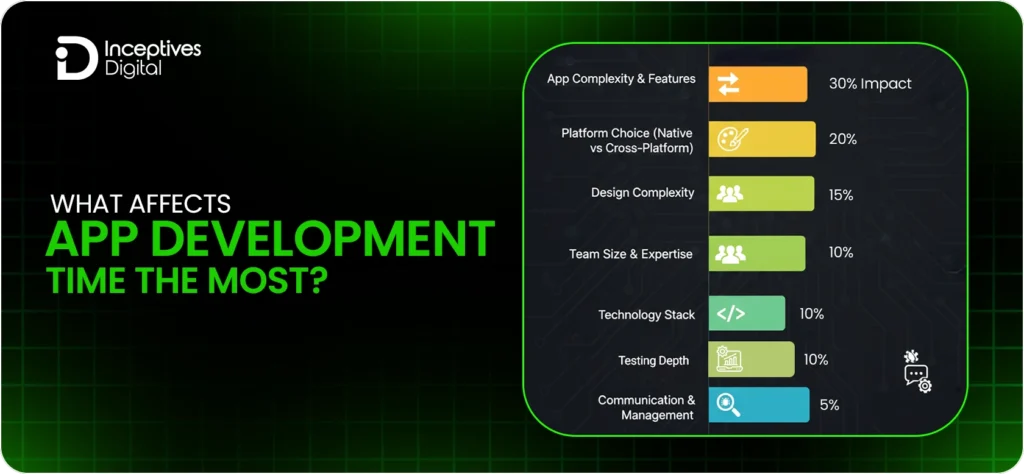
We have listed key factors that can affect your app development timeline.
- App Complexity & Features
The complexity level of your app has a huge impact on your app development timeline. The more feature-heavy your application is, the more time it will take for completion. For instance, the timeline to develop a simple app with basic features takes 2 to 4 months, and an app with advanced features like chats, maps, and payments takes 7 to 12 months or more to complete.
- Platform Choice
Choose your development platform wisely for a smart and efficient app development timeline. If you choose to develop a native app, you will need to develop separate applications for both iOS and Android devices, which increases the app development time. However, a cross-platform app runs on both devices from a single codebase that can save you a lot of time and money as well.
- Design Complexity
As we discussed earlier, every new functionality or feature adds extra time to the overall app development time. The complexity level of your app design is also one of the many factors affecting the timeline. A design that includes heavy graphics like animations, transitions, and custom layouts can make a hike in the development time.
- Team Size & Expertise
United and proficient personnel, to a great extent, can reduce development time. Just to illustrate, a project overseen by a group of experienced mobile app developers, designers, and QA engineers can move up to 30% faster as compared to a project managed by a small or less experienced team.
Working in a parallel manner is a great advantage of larger teams (one such scenario is that while visuals are being refined by designers, developers can already start on backend building). However, a small team or a single developer may take longer to finish an entire project when working through each stage one after the other.
- Technology Stack
The technology stack you select, the programming languages, frameworks, and libraries, also have an impact on the app development timeline. The use of modern and well-supported technologies like Node.js, Firebase or Flutter app development can quicken the pace.
On the other hand, the dependency on old-fashioned or technically very complex technologies may delay the entire process as a result of poor support, difficulties in integration, and debugging.
- Integration Needs
Third-party APIs are used by a lot of applications for a variety of functionalities like payment systems, maps, chat tools, or analytics. The process of integrating these APIs may last from 1 week to 4 weeks, depending mainly on the complexity of the API and the quality of the documentation.
Unstable or poorly documented APIs may cause delays in testing, and troubleshooting will require additional time.
- Testing & Quality Assurance
Skipping or rushing the testing and QA can result in costly fixes and user dissatisfaction after the launch. We recommend performing the QA and testing patiently and carefully. The more comprehensive your testing process is, the longer the app development timeline will be. We recommend working with expert app developers for a faster, efficient, and reliable QA and testing process.
- Project Management & Communication
Efficient communication and organized project management are the deciding factors that determine the timeline. That is why teams employing Agile methods, having continuous sprint reviews and documentation, are the ones that complete their projects quicker and with less number of changes.
To summarize, every factor has its own way of impacting the app development timeline. Proper planning of the strategy that includes balancing the factors of complexity, design quality, and efficiency guarantees that the app is ready for launch on time without degrading performance or user experience.
How to Reduce App Development Time Without Losing Quality
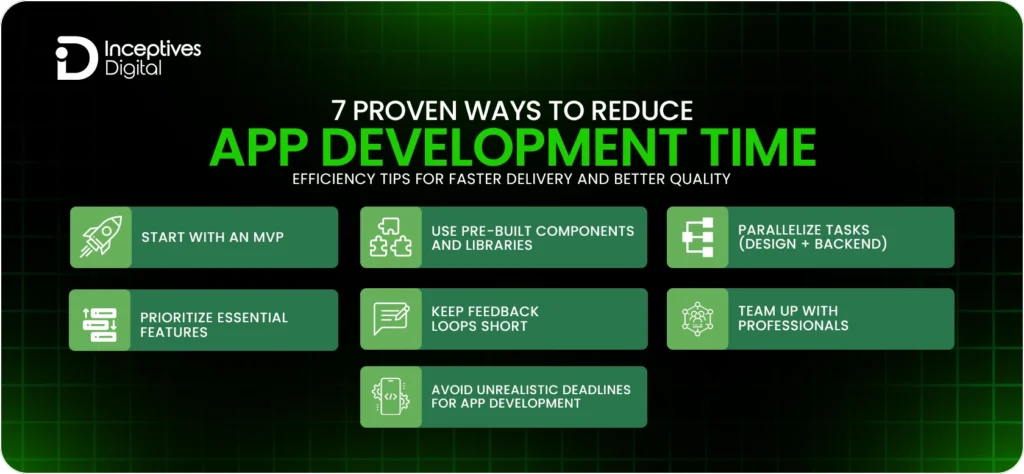
There is no need to resort to shortcuts to build an app quickly. By taking an intelligent route and making a few smart decisions at the beginning, you can increase the pace of the development while still providing a good and polished product. Here is the way to do it.
Start With a Minimum Viable Product (MVP)
Do not even think about fitting all the features into your app from day one. Create an MVP comprising only the essential features that eliminate your users’ most significant problem. This not only keeps your app in the loop sooner, but also enables you to gather actual feedback and make adjustments before the big launch. And most importantly, it is affordable.
Lean on Pre-Built Tools
Why begin from scratch? Collect trustworthy third-party libraries, frameworks, or templates to cut down on the time you spend by tons. The tools are widely used, so you can focus on producing the special features that make your app different from others.
Team Up with Pros
A competent group that is very familiar with your tech stack can perform miracles. They’ve seen it all, so they will catch possible challenges quickly, make the process easier, and keep it going. Hiring good employees not only means faster development but also a stable and durable application.
We have simplified how you can find the best mobile app development company.
Keep Feedback Tight
Long feedback waiting periods can be a major factor in the loss of momentum. Quick check-ins, usage of project management tools, and regular short updates can keep all the people involved informed. This way, problems are caught early on before they change into expensive headaches.
Work in Parallel
Don’t make teams wait on each other. Let backend devs build databases and APIs while designers craft the UI/UX and frontend. This overlap keeps the project humming and shaves time off the schedule.
Do not let teams wait on one another. Allow backend developers to create databases and APIs while designers are working on the UI/UX and frontend. The overlapping of these activities keeps the project going and cuts the time off the schedule.
Focus on What Matters
Initially, focus on the core features that are crucial and define your app’s purpose and user experience. The extras can be rolled out later once the application starts gaining traction.
Skip Unrealistic Deadlines
Hastening the design of a complicated application in an incredibly short time always results in poor coding and accumulation of “technical debt”. Those immediate solutions that eventually cause problems. Make a timeline that is realistic and allows you the time to test, improve, and create something that can expand.
You can get your application out quicker by gradually opening it up, being efficient, and maintaining flexibility without sacrificing quality. The time that you save each week should be due to clever planning and not to cutting corners or going back to redo work.
CTA SECTION START
cta title: Want to build your app faster without sacrificing quality?
cta des:
cta button: Let’s Build Smart & Fast
CTA SECTION END
Common Reasons Behind Delays In App Development
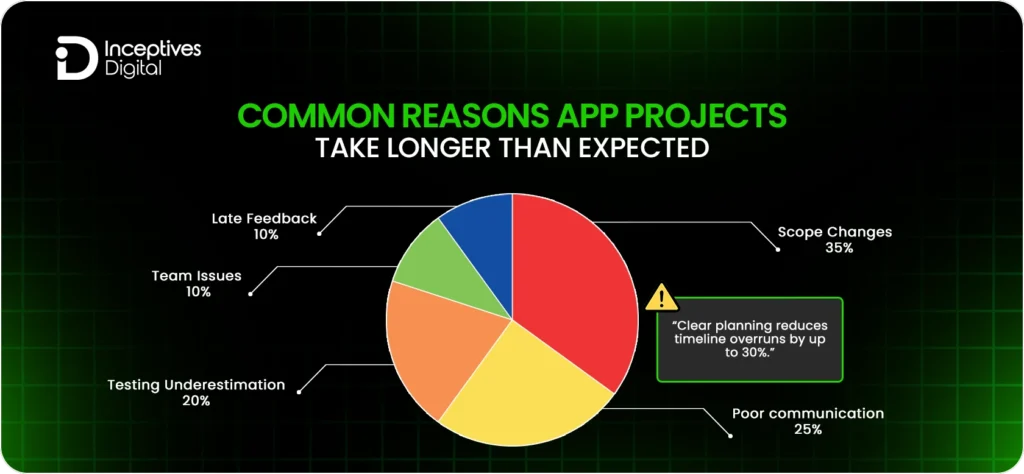
There are multiple reasons that cause delays in the app development process. Here are some common problems listed that you may face during the development of your application.
- Poor Communication and Unclear Scope
Communication is the bridge between the different departments working on the project, which includes developers, designers, and testers. Having clear communication between them is the key to completing your project in the planned timeframe. We have seen multiple projects get delayed from the intended time due to poor communication. We suggest hiring a technical project manager who will supervise the whole app development lifecycle and keep the team informed and integrated.
- Frequent Feature Changes
The features should be finalized, otherwise, it can really create a mess out of your project. Mismanagement and planning of necessary features and integrations will need frequent rework, which results in long delays. To avoid delays and frustration at the eleventh hour, we suggest developing an MVP and seeking feedback from users. This approach saves you from frequent feature changes and ensures a smooth on-on-time app development process..
- Inexperienced or Understaffed Development Teams
Often, companies make the mistake of hiring inexperienced staff or fewer team members than required just to reduce the overall development cost. This could result in low quality and a delayed project. If you really want to cut costs smartly to avoid quality downgrading and extending the project timeline, read this guide, “ App development Cost Breakdown”.
Real-World App Development Examples and Timelines
It is not that difficult to understand how long the app development takes after looking at real examples. How long will your app take to develop? That depends on how complex your project is, the features, and the size of your development team. Here is how the development timeline usually looks based on the scope of your project.
- Example 1: Simple Application
Usually, a basic application having simple functionalities, such as a to-do list or habit tracker, takes approximately 8 to 12 weeks to get fully developed. The applications of this type usually consist of a handful of screens, easy navigation, user login, and data saving. As there is no major backend support or intricate logic, the whole activity is mainly concentrated on perfecting the design and providing the users with a smooth experience.
- Example 2: Medium Complex Application
For medium-complexity applications, such as food delivery or fitness tracking, the duration is usually around 5 to 7 months. They include various user roles (customers, vendors, admins, etc.), real-time updates, payment gateways, and integration with third-party APIs.
The duration increases further because testing and quality assurance are done rigorously in order to ensure the seamless functionality of all the components, from order tracking to payments. The coordination among the frontend, backend, and design teams greatly affects the project timeline, and thus, it is a significant factor in meeting the schedule.
- Example 3: Highly Complex Application
Fintech, eCommerce marketplaces, and enterprise management systems are examples of complex apps whose development can take 10 months or more. These kinds of projects will use AI, real-time analytics, data security on the highest level, and scalable cloud infrastructures as the basis of their advanced features.
The project also needs more personnel and longer planning. Now, the coordination among developers, designers, QA engineers, and product managers is very important. The project is often very long in terms of development because it needs to go through many iterations to be good enough for both performance and compliance.
The different timelines are mainly due to differences in scope, scale, and synchronization. Having a crystal-clear roadmap, well-defined objectives, and seamless communication among the teams will be super critical, especially when the complexity of your app increases.
Wrapping Up
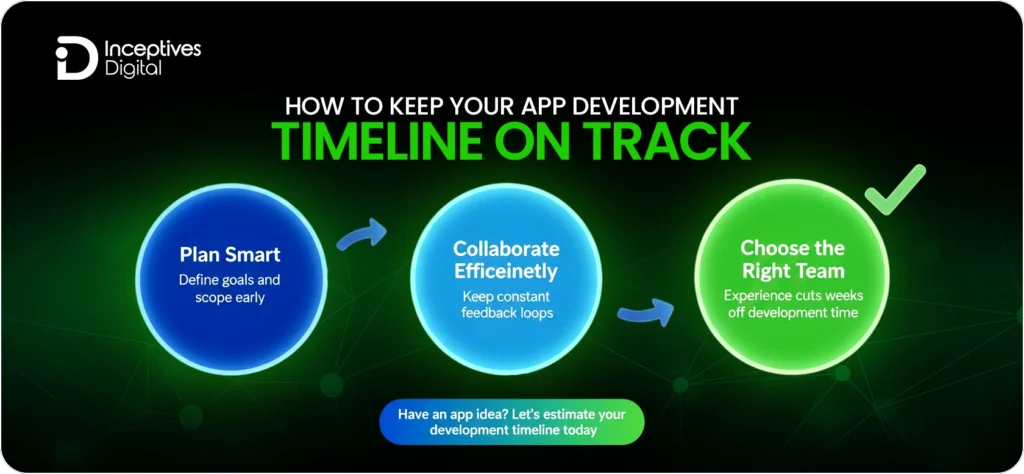
So now you have an idea of the timeline of app development. It depends on the complexity level, features, scale, team composition, and planning.
The average app development timeline for a full-fledged application is approximately 7 to more than 12 months. Whether you are looking to build a mobile application or a complex, heavy graphics mobile game, for mobile game development, we recommend consulting with experienced and trusted experts to have a clear time estimate for your project.
Inceptive Digital is a well-known custom software development company in the USA. Feel free to reach out for a custom cost and time estimate for your project. Contact Us now!
CTA SECTION START
cta title: Every app timeline is different — but with the right plan.
cta des:
cta button: Schedule a Consultation
CTA SECTION END
FAQs About App Development Timeline
The time to develop an app in 2025 varies based on the complexity level, features, and team expertise, etc. A simple app can be developed in 2 to 3 weeks, but a highly complex application with advanced integrations can take several months.
The fastest way to develop a mobile app is by using low-code or no-code platforms. You can also take help from AI tools that can fast-track your development process. But we suggest consulting with an expert app development company for a reliable product.
The complexity affects the development timeline because a simple app needs fewer features and testing, whereas a complex app has more features and integrations, which need rigorous testing as well. This results in increasing the development time for complex applications compared to simple applications.
Yes, a simple app can be developed in 1 month, but a medium complexity app can take 3 to 4 months to be released as a fully functional and polished application.
SIDEBAR LIST START
- Introduction
- Average App Development Timeline by App Complexity
- Native vs Cross-Platform App Development Time Comparison
- Stage-by-Stage Breakdown of the App Development Process
- Key Factors That Influence App Development Time
- How to Reduce App Development Time Without Losing Quality
- Common Reasons Behind Delays in App Development
- Real-World App Development Examples and Timelines
- Wrapping Up: How Long Will Your App Take to Develop?
- FAQs About App Development Timeline
SIDEBAR LIST END